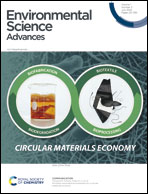Preparation, characterization, and methylene blue dye adsorption study of silk fibroin–graphene oxide nanocomposites
Abstract
In the current study, an attempt was made to fabricate silk fibroin/graphene oxide (SF/GO) blend films. The obtained blend films were characterised by UV-visible spectroscopy (UV-Vis), which confirmed the blending of GO with SF. Field emission scanning electron microscopy (FE-SEM) images depicted the good distribution of GO in SF, enhancing the roughness of the film. The thermal stability of the SF/GO films was enhanced over that of native SF, as revealed by thermogravimetric analysis (TGA). Both the pristine SF and SF/GO blend films were investigated as novel methylene blue (MB) adsorbents, with good removal efficiencies of 86% and 96%, respectively. The influences of pH, contact time, concentration and adsorbent dose on the dye adsorption were systematically examined. The MB adsorption kinetics validated the pseudo-second-order model with the preferable linear fit for both the SF (R2 = 0.995) and SF/GO blend films (R2 = 0.993). The isotherm studies revealed that both the Freundlich and Langmuir models could accurately describe the adsorption, with the Freundlich model providing a better fit (R2 = 0.989 (SF), R2 = 0.997 (SF/GO)). The maximum sorption capacity for MB was estimated to be 235.84 mg g−1 for SF and 381.67 mg g−1 for the SF/GO blend films. This suggests that the as-prepared biocompatible, nontoxic SF and SF/GO blend films can serve as effective biosorbents for the treatment of dye effluents.



 Please wait while we load your content...
Please wait while we load your content...